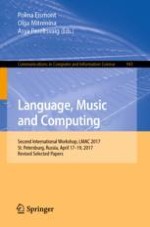2019 | OriginalPaper | Chapter
The Role of Truth-Values in Indirect Meanings
Authors : Basil Lourié, Olga Mitrenina
Published in: Language, Music and Computing
Publisher: Springer International Publishing
Activate our intelligent search to find suitable subject content or patents.
Select sections of text to find matching patents with Artificial Intelligence. powered by
Select sections of text to find additional relevant content using AI-assisted search. powered by
